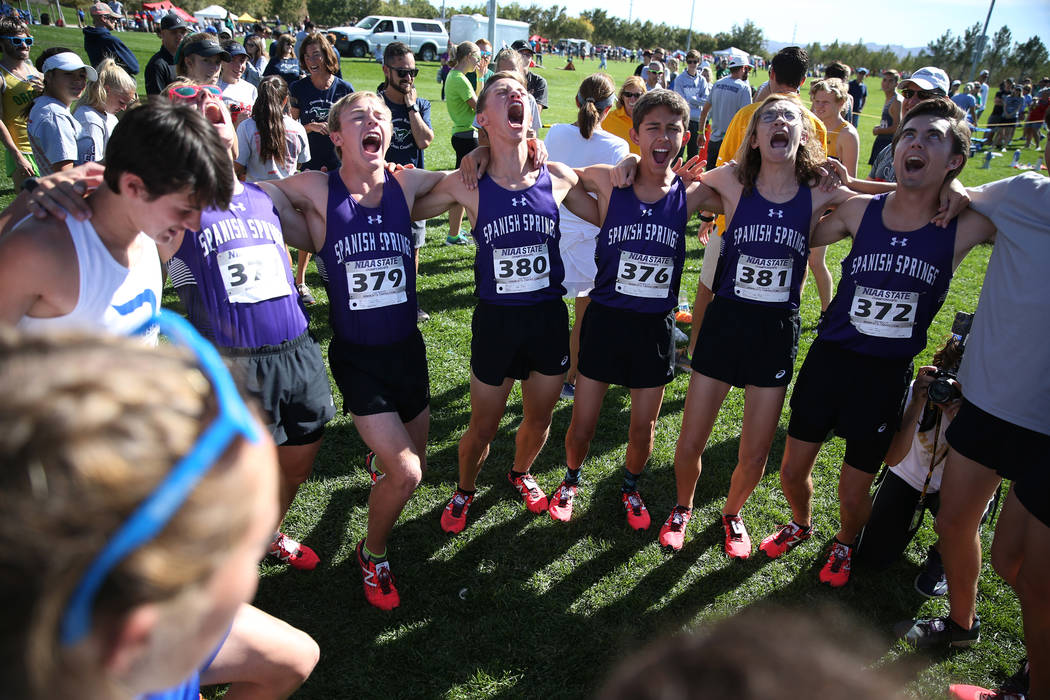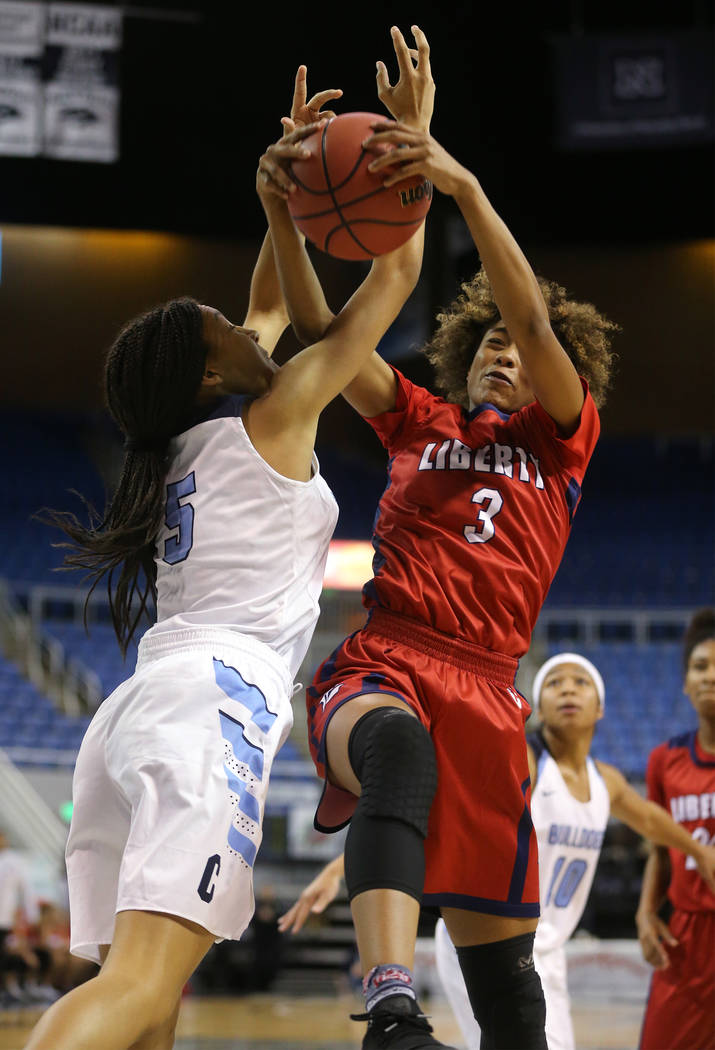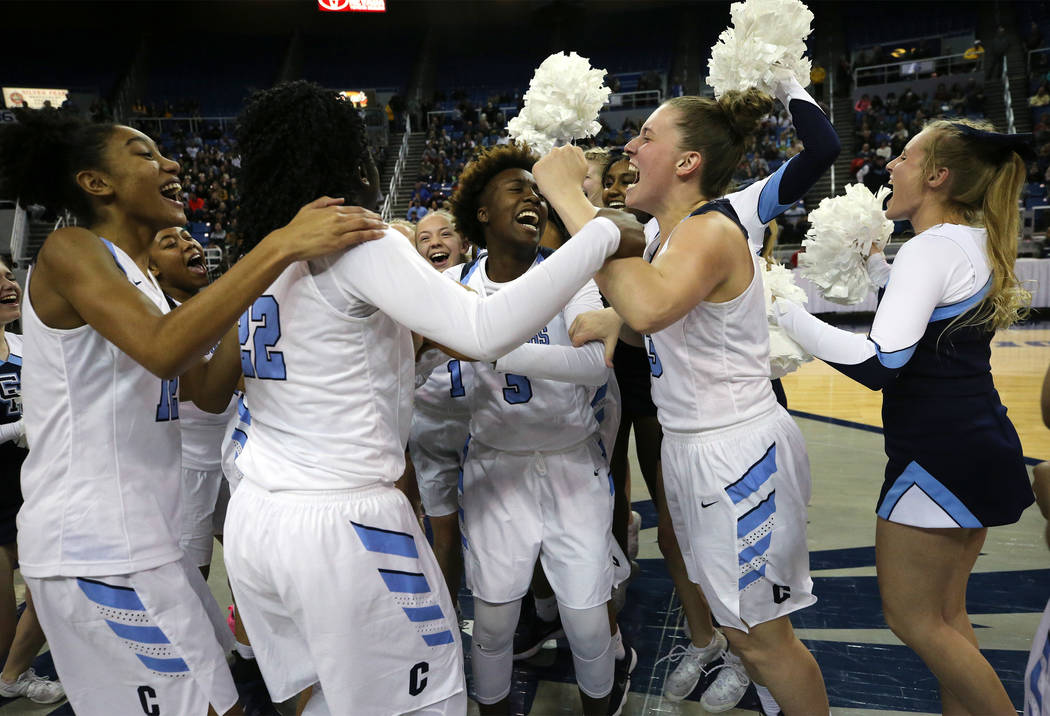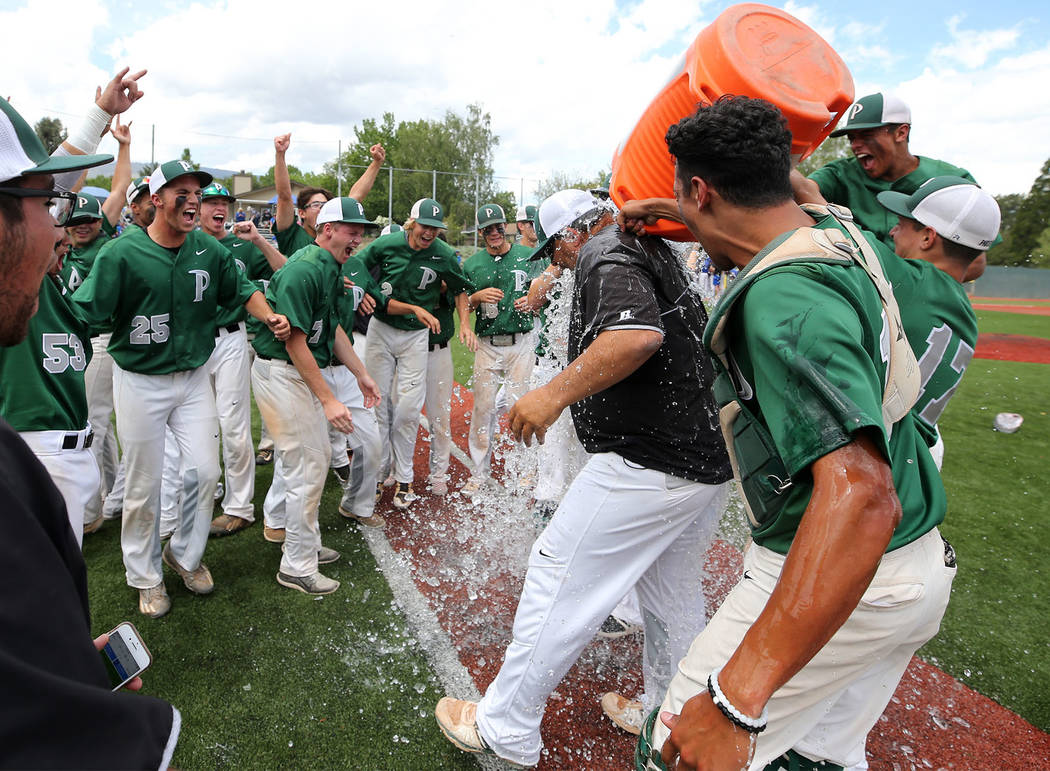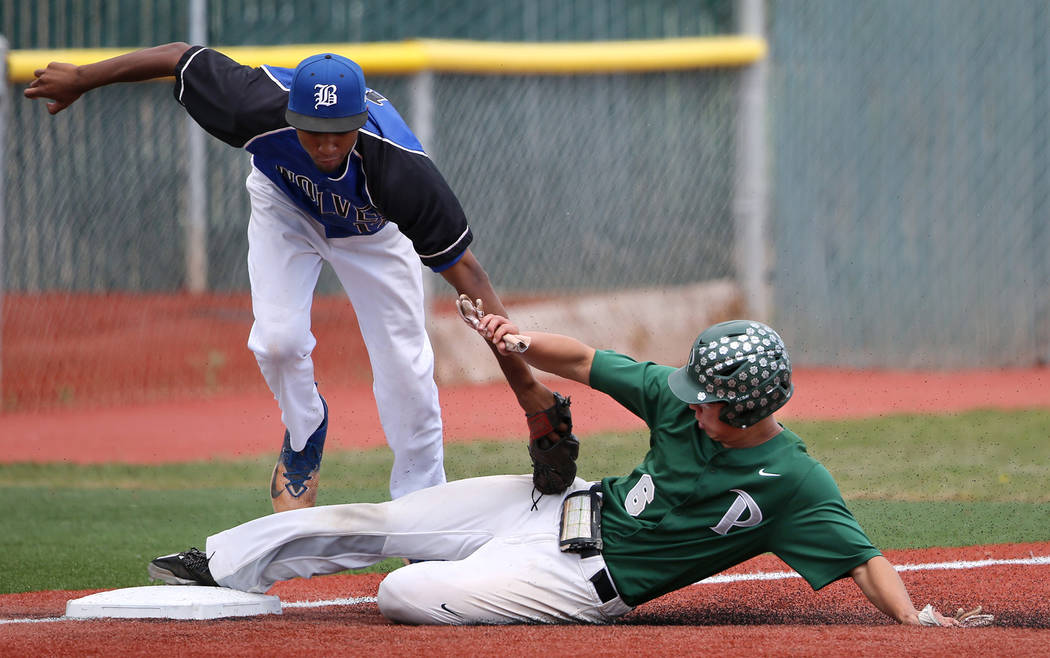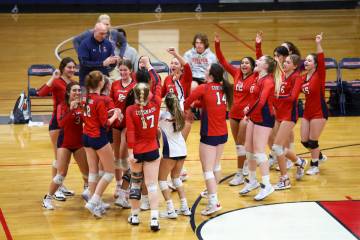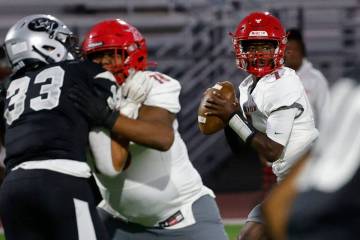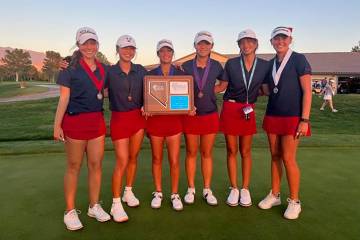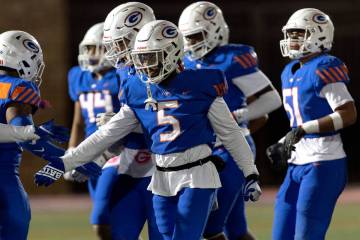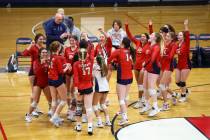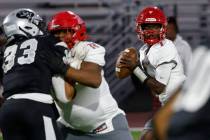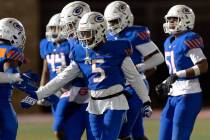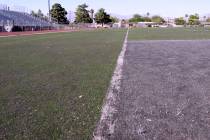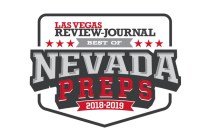Southern Nevada schools shoulder load for state tournament travel
When Palo Verde High School defeated Basic for the 2018 Class 4A state baseball title, the Panthers celebrated the victory over their Southern Nevada rivals with a dogpile on the infield.
At Bishop Manogue High School — in Reno.
It was a familiar occurrence.
The last five times the large-school state baseball tournament has been played in Reno, two teams from Southern Nevada played for the title. It’s a symptom of an annual north-south state championship rotation that no longer may be equitable, at least at the Class 4A level.
Clark County is home to a plurality of the state’s schools, and at the Class 4A level, the largest classification for high school sports in Nevada, 27 of the 39 schools.
“That wasn’t the case when that was all set up years ago,” said Donnie Nelson, assistant director for the Nevada Interscholastic Activities Association. “The north-south numbers did balance years ago, but they don’t anymore.”
With state tournament sites in all sports except Class 4A football alternating between the Las Vegas and Reno areas each season, local schools have faced a heavier travel burden than their Northern Nevada counterparts.
The Clark County School District has spent $467,587 in the past two years traveling to state tournaments. That’s more than double what Northern Nevada’s largest county has spent during the same period, as the Washoe County School District reported $214,393 in expenditures.
Rotating sites, big costs
The Clark County School District reported spending $294,680 to send students to state championship events in 2017-18. That figure does not include the travel costs of regular-season or postseason competition before state tournaments. The amount also does not reflect the costs incurred by Southern Nevada private schools, such as Bishop Gorman and Faith Lutheran. And it does not account for the travel expenses of athletes’ family members, who pay their own way.
The 2017-18 school year was especially expensive for Clark County, with football, boys and girls basketball, baseball, softball, boys and girls soccer, boys and girls track, and boys and girls cross country contested in the Reno area. Girls volleyball, boys and girls tennis, boys and girls golf, wrestling, and boys and girls swimming state championships were held in the Las Vegas Valley.
In 2016-17, when more championships were contested in the south, Washoe County reported $132,458 spent on state title travel and CCSD reported $172,907 in expenditures.
Even in years when Las Vegas hosts the majority of events, Clark County is spending more than Washoe on travel.
“I know coaches and schools a lot of times say, ‘Why don’t we play state twice down south and once north?’ ” Clark County athletic director Pam Sloan said. “But the (NIAA) has said that’s not fair to Washoe and other counties to put them in that financial situation. Financially it would be nice, but for fairness, that’s what’s been agreed upon.”
Washoe County is in no rush to change the system.
“Of course we’re going to like how it is because it rotates every year,” said Rollins Stallworth, Washoe County coordinator of activities and athletics. “I’m not going to go against that, but my viewpoint of the job here is that the unfortunate situation in Clark County is it’s so big.”
The spring season can be especially expensive, with baseball, softball and and track always contested in the same area. Sloan said she sent 16 charter buses to the Reno area for spring tournaments, 10 to accommodate track athletes.
“I was pinching pennies last year, and we made it work,” Sloan said.
Change not on the horizon
Nelson conceded that alternating between the two regions made more sense when the NIAA had only a Northern and a Southern Region in Class 4A, before Clark County’s population boom necessitated a second South Region.
The NIAA still is adjusting. This season, team sports other than football will expand their state tournaments from four to six teams in Class 4A. In the past, the south would send two teams when the tournaments were held in the north, but three when championships were held in the south. Starting this year, state tournaments will have four southern representatives and two northern regardless of where the games are played.
But more teams mean more travel expenses. Neither Sloan nor Stallworth, who are NIAA Board of Control members, put up a fight at the meeting when that was decided. They said they would make it work.
Could there come a time when the bubble pops and it no longer makes financial sense to send schools more than 400 miles to compete?
“That’s always a concern,” Stallworth said. “But before they would stop that, we would look at other revenues to raise some funds maybe, increase student fees or something.”
The Board of Control has nine members: five representing Southern Nevada and four from Northern Nevada. The five southern members are Sloan, two CCSD principals and two Clark County School Board trustees.
Carolyn Edwards is one of the trustees, and she acknowledged, as Nelson did, that the current system of alternating host sites between the north and the south might be outdated. As a former president of the Nevada Association of School Boards, she said there is always a balancing act to making sure the north is not left out in all regards, not just sports.
“You have the capital in Carson City, and now the majority of the population is in the south. That’s a lot of travel for a lot of people,” Edwards said. “I suspect the feeling is you put it in the south and that’s the only interest that will be represented.”
Edwards also acknowledged the power Southern Nevada has on the NIAA board. With a majority of its members associated with CCSD, if all five of them thought the south was being wronged and the costs were too great for Clark County, could they move everything to the Las Vegas area?
“We could. But we are also respectful of the balance, of what’s fair and all of that,” she said. “I don’t think rural counties should bear all the burden of travel. They already bear a huge travel burden because of how far they have to travel just for (regular-season) games.
“I think part of the issue is you have to pay attention to those concerns as well, and you can’t just do what’s in the best interests of Clark County. I sit on this board representing all students across the state. I do not represent Clark County alone. I represent Clark County’s voice, but when I vote, it’s a vote for what’s right for all students.”
Possible solutions
The most recent statewide realignment almost had a solution for state tournament travel: the creation of a Class 5A.
The travel costs would have been mitigated, had an 11th-hour proposal not been approved. The NIAA’s realignment committee approved the fifth classification in early 2017 and decided on specifics in December. Class 5A would have included schools exclusively from Southern Nevada, ensuring that all of its state championships would be played in Clark County. Class 4A would have had close to equal representation between Northern and Southern Nevada schools.
The issue became controversial. A group of CCSD principals, feeling slighted that they had no representation or voice on the realignment committee, banded together to form their own proposal that kept the four-class configuration. Two dozen of them flew to Reno for January’s meeting, and the NIAA board voted 7-2 in favor of the principals’ proposal. Sloan and Stallworth voted in favor of the four-class alignment.
Another way to make the travel burden more equitable would involve a major change for the NIAA, though not as drastic as a 5A classification that would essentially end statewide championships for Nevada’s largest schools.
Football uses a three-way rotation for its Class 4A championship games, with each of the state’s three regions — two in the south, one in the north — hosting the final once every three years. The NIAA could apply the football postseason model and have state tournaments in Southern Nevada two out of three years. But that, too, seems unlikely to happen anytime soon.
“It has been loosely talked about in realignment and tournament format committee meetings,” Nelson said. “I can’t say it’s ever been an action item.
“If there is to be a 5A someday in this state, then depending on what that classification ends up being … that could change everything.”
Large-school disparity
The Clark County School District has 39 of the 104 NIAA member schools eligible for state tournaments. The next largest district, Washoe, has 11.
But there were 25 Class 4A schools in Southern Nevada for the NIAA’s 2016-18 realignment cycle, 23 of them in CCSD. There were 12 schools from the north, nine of them from the Washoe County School District.
The regional balance levels out in the lower classifications, where most rural schools compete. Clark County has 11 of 12 schools in the 3A Southern Region, one of nine in 2A and three of nine in 1A.
State tournaments are designed with all four classes in mind. Every sport but football has its state championship at the same time for all classes, with multiple classes often sharing a facility. Nelson said the current configurations of the Class 3A, 2A and 1A schools wouldn’t justify having two state championships contested in Las Vegas every three years.
“When the committees set it up, it was about balancing the numbers of student-athletes traveling,” Nelson said. “Separating them and getting the large schools away from the other three classifications hasn’t made sense to anybody. I’m not sure people see that as a good thing.”
Teams like making memories
Football is the largest sport in terms of roster size. Sloan said CCSD pays for 48 people, but it’s up to the schools to determine how to divide that among players, coaches and administrators. The schools must pay for anyone else to go.
Bishop Gorman and Liberty have won the two Southern Region titles every year since 2009 and are the only Southern Nevada schools that have traveled for a state semifinal or championship football game in that span. Because Bishop Gorman is a private school, Liberty is the only 4A school in the past decade to need CCSD funds for football state championship travel.
Liberty brings its team — typically about 60 players plus coaches — on a bus Friday morning for seven hours, stays in a hotel that night, plays football Saturday and heads home after the game.
It’s a bit of a grind, but coach Rich Muraco said what plenty of other coaches and players across Clark County have said: It’s worth the cost.
“It definitely is a bonding experience for the kids. It’s something they’re going to remember, so they love it, love going up there,” Muraco said. “We like taking on the Reno teams.”
So does Palo Verde baseball coach Joe Hallead, whose team played two Northern Nevada schools on their home fields in the state tournament.
“It was sort of neat playing up in Reno because we got to go on the bus ride,” Hallead said. “The guys got to bond. (It was) one of those things to make lifelong memories.”
Contact prep sports editor Damon Seiters at dseiters@reviewjournal.comor 702-380-4587. Follow @DamonSeiters on Twitter. Contact Justin Emerson at jemerson@reviewjournal.com or (702) 387-2944. Follow @J15Emerson on Twitter.



